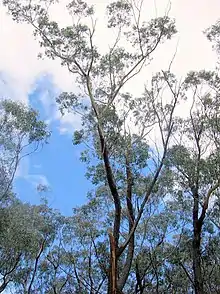| Silvertop ash | |
|---|---|
 | |
| Silvertop ash at Katoomba | |
| Scientific classification | |
| Kingdom: | Plantae |
| Clade: | Tracheophytes |
| Clade: | Angiosperms |
| Clade: | Eudicots |
| Clade: | Rosids |
| Order: | Myrtales |
| Family: | Myrtaceae |
| Genus: | Eucalyptus |
| Species: | E. sieberi |
| Binomial name | |
| Eucalyptus sieberi | |
| Synonyms[1] | |
| |
Eucalyptus sieberi, commonly known as the silvertop ash or black ash,[2] is a species of medium-sized to tall tree that is endemic to south-eastern Australia. It has rough bark on the trunk and the base of larger branches, and smooth bark above. It has lance-shaped to curved adult leaves and flower buds in groups of seven to fifteen, which bear white flowers and barrel-shaped or conical fruit.
Description
Eucalyptus sieberi typically grows to a height of 25–45 m (82–148 ft) and does not form a lignotuber. It has rough bark on the trunk and the larger branches, and smooth, white to yellow bark above. The rough bark is thin and flaky on younger trees but, with age, it becomes thick, dark grey to black, and furrowed. Young trees have egg-shaped to lance-shaped or curved, bluish green to glaucous leaves that are 60–170 mm (2.4–6.7 in) long and 16–75 mm (0.63–2.95 in) wide. Adult leaves are the same shade of glossy green on both sides, lance-shaped to curved, 85–195 mm (3.3–7.7 in) long and 12–38 mm (0.47–1.50 in) wide on a petiole 10–20 mm (0.39–0.79 in) long.
The flower buds are arranged in leaf axils in groups of between seven and fifteen, on an unbranched peduncle 8–16 mm (0.31–0.63 in) long, with the individual buds on pedicels being 3–7 mm (0.12–0.28 in) long. Mature buds are oval to club-shaped, 3–5 mm (0.12–0.20 in) long and 3–4 mm (0.12–0.16 in) wide, with a rounded or flattened operculum. Flowering occurs from September to January and the flowers are white. The fruit is a woody barrel-shaped or conical capsule, 6–11 mm (0.24–0.43 in) long and 6–9 mm (0.24–0.35 in) wide, with the valves near rim level.[2][3][4][5]
Taxonomy and naming
Eucalyptus sieberi was first formally described in 1962 by Lawrie Johnson in Contributions from the New South Wales Herbarium, from specimens collected by Joseph Maiden in Blackheath in 1899.[6] The specific epithet (sieberi) honours the Czech botanist Franz Sieber.[3]
Distribution and habitat
Silvertop ash grows in forest and woodland, often in pure stands, on shallow soils of low to medium fertility. It is found in south-eastern Queensland, through the western slopes and plains of New South Wales, the eastern side of the Great Dividing Range in Victoria, and north-eastern Tasmania.[2][3][4][5][7]
Uses
The timber is used in general construction, flooring, decking, handles and woodchipping. It is one of the major species being converted into export wood chips at Eden for writing paper production.[8][9]
Gallery
 Adult leaves
Adult leaves Buds
Buds Fruit
Fruit Trunk bark
Trunk bark Upper branch bark
Upper branch bark
References
- 1 2 "Eucalyptus sieberi". Australian Plant Census. Retrieved 23 December 2019.
- 1 2 3 Hill, Ken. "Eucalyptus sieberi". Royal Botanic Garden Sydney. Retrieved 23 December 2019.
- 1 2 3 "Eucalyptus sieberi". Euclid: Centre for Australian National Biodiversity Research. Retrieved 29 May 2020.
- 1 2 Chippendale, George M. "Eucalyptus sieberi". Australian Biological Resources Study, Department of the Environment and Energy, Canberra. Retrieved 23 December 2019.
- 1 2 Brooker, M. Ian H. "Eucalyptus sieberi". Royal Botanic Gardens Victoria. Retrieved 23 December 2019.
- ↑ "Eucalyptus sieberi". APNI. Retrieved 23 December 2019.
- ↑ Jordan, Greg. "Eucalyptus sieberi". University of Tasmania. Retrieved 23 December 2019.
- ↑ "Silvertop ash". Timber Development Association. Archived from the original on 18 February 2011. Retrieved 23 December 2019.
- ↑ Bootle, Keith (2005). Wood in Australia: types, properties and uses (2nd ed.). New York: McGraw-Hill. ISBN 0-07-471312-4.